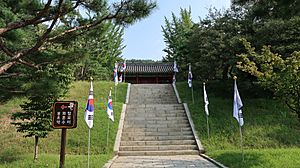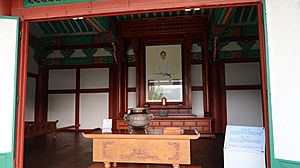Yu Gwansun facts for kids
Quick facts for kids
Yu Gwan-sun
|
|
|---|---|
 |
|
| Born | December 16, 1902 Cheonan, South Chungcheong, Korea
|
| Died | September 28, 1920 (aged 17) |
| Known for | March 1st Movement |
| Parents |
|
| Relatives |
|
| Korean name | |
| Hunminjeongeum | |
| Hanja | |
| Revised Romanization | Ryu Gwan-sun |
| McCune–Reischauer | Ryu Kwan-sun |
Yu Gwan-sun (born December 16, 1902 – died September 28, 1920) was a brave young Korean activist. She played a big part in the March First Independence Movement. This movement was a peaceful protest against Japan's rule over Korea. Yu Gwan-sun became a famous symbol of Korea's fight for freedom.
Contents
Early Life and Schooling
Yu Gwan-sun was born on December 16, 1902, near Cheonan, in South Chungcheong Province, Korea. She was the second of three children. Her family was Protestant, and she grew up in this faith.
People thought she was very smart. She could remember parts of the Bible after hearing them just once. Yu Gwan-sun went to a school called Ewha Hakdang, which is now Ewha Womans University. She got a scholarship, which meant she had to work as a teacher after she finished school. Not many women went to university back then.
In 1919, while she was a student at Ewha Girls' High School, she saw the start of the March First Independence Movement. Yu and a small group of friends joined the protests in Seoul. On March 10, 1919, the Japanese government closed all schools, including Ewha Women's School. Yu then went back home to Cheonan.
What Was the March First Movement?
On March 1, 1919, many people in Seoul protested against Japan's control of Korea. After this big protest, organizers asked Yu and her friends to join another demonstration. This one was planned for March 5, 1919.
Yu and her classmates marched to Namdaemun in Central Seoul. The police arrested them there, but missionaries from their school helped them get released quickly. Yu left Seoul when the Japanese government ordered all Korean schools to close because of the protests. She went back to her village, Jiryeong-ri. There, she became even more involved in the independence movement.
Organizing a Protest in Her Hometown
Yu Gwan-sun and her family went from house to house. They asked people to join the independence movement. She told everyone about a protest she was planning with Cho In-won and Kim Goo-Eung. She gathered people from nearby towns like Yeongi, Chungju, Cheonan, and Jincheon.
The protest happened on April 1, 1919, at Aunae Marketplace. About 3,000 people gathered and shouted, "Long live Korean independence!" (Korean: "대한독립만세"). Japanese military police arrived and shot at the unarmed protesters. Nineteen people died, including Yu's parents. Yu was arrested.
The Japanese police offered Yu a lighter sentence. They wanted her to admit she was guilty and help them find other protesters. But Yu refused. She stayed silent, even after being badly tortured.
Yu Gwan-sun's Time in Prison
After her arrest, Yu was first held at the Cheonan Japanese Military Police Station. Later, she was moved to Gongju Police Station. At her trial, she argued that the Japanese government controlled the court. She said the judge was Japanese and the laws were unfair.
Even though she tried to get a fair trial, she was found guilty. She was sentenced to five years in Seodaemun Prison in Seoul. While in prison, Yu kept supporting the independence movement. Because of this, she was severely punished and tortured.
On March 1, 1920, Yu planned a big protest with other prisoners. This was to mark the first anniversary of the March First Movement. Yu was then put in a separate, isolated cell. She died on September 28, 1920. Her death was caused by injuries from torture and beatings in prison.
Records from 2011 show that 7,500 of the 45,000 people arrested during these protests died because of the Japanese authorities.
While in prison, Yu wrote:
Even if my fingernails are torn out, my nose and ears are ripped apart, and my legs and arms are crushed, this physical pain does not compare to the pain of losing my nation. [...] My only remorse is not being able to do more than dedicating my life to my country.
After Yu Gwan-sun's Death
At first, Japanese prison officials did not want to release Yu's body. They wanted to hide proof of the torture. But Lulu Frey and Jeannette Walter, the principals of Yu's school, threatened to tell the public about their suspicions of torture. So, the authorities finally released her body in an oil crate.
Jeannette Walter dressed Yu for her funeral. In 1959, Walter told the public that Yu's body had not been cut into pieces, as some rumors claimed. On October 14, 1920, Yu's funeral was held at Jung-dong Church. Her body was buried in a public cemetery in Seoul's Itaewon district. This cemetery was later destroyed.
After Korea became free in 1945, a special shrine was built for Yu in Byeongcheon-myeon. People from Ewha Womans University have held a memorial service for Yu every year since 1946.
Her body was buried in Itaewon Cemetery. However, the Japanese Empire moved the tomb to build a military base, and her body disappeared. Today, her grave in Cheonan, Chungcheongnam-do, does not contain her body.
Yu Gwan-sun's Legacy
Yu Gwan-sun became known as "Korea's Joan of Arc". The March 1st Movement did not immediately free Korea. However, the Japanese government did start to use less strict controls. Yu never gave up her beliefs, even after being arrested. Because of her strong protests and resistance, she became a symbol of the Korean independence movement.
After Korea gained independence, a shrine was built to honor Yu. This was done with help from South Chungcheong province and the city of Cheonan. In 1962, she was given the Order of Independence Merit award after her death. In 2018, The New York Times published an obituary for her, many years later.
Women's Declaration of Independence
Yu Gwan-sun wrote powerful words while in prison. She spoke about the duty to create a new, independent nation. She urged her fellow Koreans not to delay their efforts for freedom.
Yu Gwan-sun Award
In South Chungcheong Province, there is an award named after Yu Gwan-sun. This award honors groups of women, including students, who have helped develop the nation and their communities.
How Yu Gwan-sun's Name is Spelled
Yu Gwan-sun was born into the Goheung Ryu clan. In South Korea, there is a rule called the "initial sound rule." This means that the sound 'ㄹ' (Ryu) at the start of a word is often dropped when spoken. So, her family name 柳 is often pronounced and written as 유 (Yu), even though its original sound is 류 (Ryu).
Both 유 (Yu) and 류 (Ryu) are understood to refer to the same family name. In 1995, the Supreme Court of Korea ruled that 柳 should be recorded as 유 in family registers. However, in 2007, people were allowed to use 류 if they wished.
The Yu-Gwansun Memorial Association used 유 from 1947. They changed it to 류 in 2001 but went back to 유 in 2014. They did this to avoid confusion, as textbooks and official documents mostly use 유.
Yu Gwan-sun in Popular Culture
Films About Yu Gwan-sun
- Portrayed by Go Chun-hee in the 1948 film Yu Gwan-sun
- Portrayed by Do Geum-bong in the 1959 film Yu Gwan-sun
- Portrayed by Eom Aeng-ran in the 1966 film Yu Gwan-sun
- Portrayed by Moon Ji-hyun in the 1974 film Yu Gwan-sun
- Portrayed by Go Ah-seong in the 2019 film A Resistance
- Portrayed by Lee Sae-bom in the 2019 film 1919 Yu Gwan-sun
Animation
- Portrayed by Jung Mi-sook in the 1993-1994 KBS animation series Cho-ryong's Old Travel
Art and Poetry
- She is mentioned in the book Dictee by Theresa Hak Kyung Cha
See also
 In Spanish: Ryu Gwansun para niños
In Spanish: Ryu Gwansun para niños



